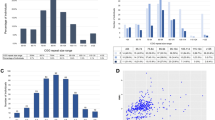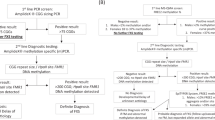Abstract
Fragile X syndrome is characterized at the molecular level by amplification of a (CGG)n repeat and hypermethylation of a CpG island preceeding the open reading frame of the fragile X gene (FMR–1) located in Xq27.3. Anticipation in this syndrome is associated with progressive amplification of the (CGG)n repeat from a premutation to a full mutation through consecutive generations. Remarkably, expansion of the premutation to the full mutation is strictly maternal. To clarify this parental influence we studied FMR–1 in sperm of four male fragile X patients. This showed that only the premutation was present in their sperm, although they had a full mutation in peripheral lymphocytes. This might suggest that expansion of the premutation to the full mutation in FMR–1 does not occur in meiosis but in a postzygotic stage.
This is a preview of subscription content, access via your institution
Access options
Subscribe to this journal
Receive 12 print issues and online access
$209.00 per year
only $17.42 per issue
Buy this article
- Purchase on Springer Link
- Instant access to full article PDF
Prices may be subject to local taxes which are calculated during checkout
Similar content being viewed by others
References
Verkerk, A.J.M.H. et al. Identification of a gene (FMR–1) containing a CGG repeat coincident with a breakpoint cluster region exhibiting length variation in fragile X syndrome. Cell 65, 905–914 (1991).
Gedeon, A.K. et al. Fragile X syndrome without CGG amplification has an FMR–1 deletion. Nature Genet. 1, 341–344 (1992).
Wöhrle, D. et al. A microdeletion of less than 250 kb, including the proximal part of the FMR–1 gene and the fragile site, in a male with the clinical phenotype of the fragile X syndrome. Am. J. hum. Genet. 51, 299–306 (1992).
De Boulle, K. et al. A point mutation in the FMR–1 gene associated with fragile X mental retardation. Nature Genet. 3, 31–35 (1993).
Kremer, E. et al. Mapping of DNA instability at the fragile X to a trinucleotide repeat sequence p(CGG)n . Science 252, 1711–1714 (1991).
Fu, Y.-H. et al. Varation of the CGG repeat at the fragile X site results in genetic instability: resolution of the Sherman paradox. Cell 67, 1047–1058 (1991).
Rousseau, P. et al. Direct diagnosis by DNA analysis of the fragile X syndrome of mental retardation. New Engl. J. Med. 325, 1673–1681 (1991).
Bell, M.V. et al. Physical mapping across the fragile X: Hypermethylation and clinical expression of the fragile X syndrome. Cell 64, 861–866 (1991).
Heitz, D. et al. Isolation of sequences that span the fragile X and identification of a fragile X–related CpG island. Science 251, 1236–1239 (1991).
Oberlé, I. et al. Instability of a 550 base pair DNA segment and abnormal methylation in fragile X syndrome. Science 252, 1097–1102 (1991).
Vincent, A. et al. Abnormal pattern detected in fragile X patients by pulsed-field gel electrophoresis. Nature 349, 624–626 (1991).
Heitz, D., Devys, D., Imbert, G., Kretz, C. & Mandel, J.–L. Inheritance of the fragile X syndrome: size of the fragile X permutation is a major determinant of the transition to full mutation. J. med. Genet. 29, 794–801 (1992).
Yu, S. et al. Fragile X syndrome: unique genetics of the heritable unstable element. Am. J. hum. Genet. 50, 968–980 (1992).
Sherman, S.L., Morton, N.E., Jacobs, P.A. & Turner, G. The marker (X) chromosome: A cytogenetic and genetic analysis. Ann. hum. Gen. 48, 21–37 (1984).
Sherman, S.L. et al. Further segregation analysis of the Fragile X syndrome with special reference to transmitting males. Hum. Genet. 69, 289–298 (1985).
Van Roy, B.C. et al. Fragile X trait in a large kindred: Transmission also through normal males. J. med. Genet. 20, 286–289 (1983).
Moric–Petrovic, S. & Laca, Z. A father and daughter with fragile X chromosome. J. med. Genet. 20, 476–478 (1983).
Loesch, D.Z. et al. Phenotypic variation in male-transmitted fragile X: Genetic interferences. Am. J. med. Genet. 27, 401–417 (1987).
Voelckel, M.A. et al. Dissociation between mental retardation and fragile site expression in a family with fragile X-linked mental retardation. Hum. Genet. 80, 375–378 (1988).
Yu, W.-D. et al. X chromosome imprinting in fragile X syndrome. Hum. Genet. 85, 590–594 (1990).
Willems, P.J. et al. Segregation of the fragile X mutation from an affected male to his normal daughter. Hum. molec. Genet. 1, 511–515 (1992).
Mulley, J.C. et al. Experience with direct molecular diagnosis of fragile X. J. med. Genet. 29, 368–374 (1992).
de Vries, B.B.A. et al. Mental status and fragile X expression in relation to FMR–1 gene mutation. Eur. J. hum. Genet. 1, 72–79 (1993).
Shelbourne, P. et al. Unstable DNA may be responsible for the incomplete penetrance of the myotonic dystrophy phenotype. Hum. molec. Genet. 1, 467–473 (1992).
Brunner, H.G. et al. Reverse mutation in myotonic dystrophy. New Engl. J. Med. (in the press).
O'Moy, K.L. et al. Reduction in size of the myotonic dystrophy trinucleotide repeat mutation during transmission. Science 259, 809–812 (1993).
Pierretti, M. et al. Absence of expression of the FMR–1 gene in fragile X syndrome. Cell 66, 817–822 (1991).
Devys, D. et al. Analysis of full fragile X mutations in fetal tissues and monozygotic twins indicate that abnormal methylation and somatic heterogeneity are established early in development. Am. J. med. Genet. 43, 208–216 (1992).
Sutcliffe, J.S. et al. DNA methylation represses FMR–1 transcription in fragile X syndrome. Hum. molec Genet. 1, 397–400 (1992).
Hinds, H.L. et al. Tissue specific expression of FMR–1 provides evidence for a functional role in fragile X syndrome. Nature Genet. 3, 36–43 (1993).
Rousseau, F., Heitz, D., Oberlé, I. & Mandel, J.-L. Selection in blood cells from female carriers of the fragile X syndrome: Inverse correlation between age and proportion of active X chromosomes carrying the full mutation. J. med. Genet. 28, 830–836 (1991).
Sutherland, G.R. et al. Prenatal diagnosis of fragile X syndrome by direct detection of the unstable DNA sequence. New Engl. J. Med. 325, 1720–1722 (1991).
Wöhrle, D. et al. Genotype mosaicism in fragile X fetal tissues. Hum. Genet. 89, 114–116 (1992).
Brook, J.D. et al. Molecular basis of myotonic dystrophy: Expansion of trinucleotide (CTG) repeat at the 3′ end of a transcript encoding a protein kinase family member. Cell 68, 799–808 (1992).
Fu, Y.H. et al. An unstable triplet repeat in a gene related to myotonic muscular dystrophy. Science 255, 1256–1258 (1992).
La Spada, A.R. et al. Androgen receptor gene mutation in X–linked spinal and bulbar muscular atrophy. Nature 352, 77–99 (1991).
Biancalana, V. Moderate instability of the trinucleotide repeat in spinobulbar muscular atrophy. Hum. molec. Genet. 1, 255–258 (1992).
Richards, R.I. & Sutherland, G.R. Dynamic mutations, a new class of mutations causing human disease. Cell 70, 709–712 (1992).
Richards, R.I. & Sutherland, G.R. Heritable unstable DNA sequences. Nature Genet. 1, 7–9 (1992).
Vergnaud, G. . et al. Use of synthetic tandem repeats to isolate new VNTR loci: Cloning of a human hypermutable sequence. Genomics 11, 135–144 (1991).
Jeffreys, A.J. et al. Mouse DNA ‘fingerprints’: Analysis of chromosome localization and germline stability of hypervariable loci in recombinant inbred strains. Nucl. Acids Res., 2823–2836 (1987).
Kelly, R. et al. Characterization of a highly unstable mouse minisatellite locus: Evidence for somatic mutation during early development. Genomics 5, 844–856 (1989).
Van Roy, B.C. et al. Two brothers with mental retardation discordant for the fragile X syndrome. Am. J. med. Genet. 36, 122–125 (1990).
Oostra, B.A. & Verkerk, A.J.M.H. The fragile X syndrome: Isolation of the gene and characterization of the fragile X mutation. Chromosoma 101, 381–387 (1992).
Author information
Authors and Affiliations
Rights and permissions
About this article
Cite this article
Reyniers, E., Vits, L., De Boulle, K. et al. The full mutation in the FMR–1 gene of male fragile X patients is absent in their sperm. Nat Genet 4, 143–146 (1993). https://doi.org/10.1038/ng0693-143
Received:
Accepted:
Issue Date:
DOI: https://doi.org/10.1038/ng0693-143
This article is cited by
-
Current advances in neuronal intranuclear inclusion disease
Neurological Sciences (2023)
-
CGG-repeat dynamics and FMR1 gene silencing in fragile X syndrome stem cells and stem cell-derived neurons
Molecular Autism (2016)
-
EMQN best practice guidelines for the molecular genetic testing and reporting of fragile X syndrome and other fragile X-associated disorders
European Journal of Human Genetics (2015)
-
Fragile X protein in newborn dried blood spots
BMC Medical Genetics (2014)
-
Longitudinal Interviews of Couples Diagnosed with Diminished Ovarian Reserve Undergoing Fragile X Premutation Testing
Journal of Genetic Counseling (2014)



